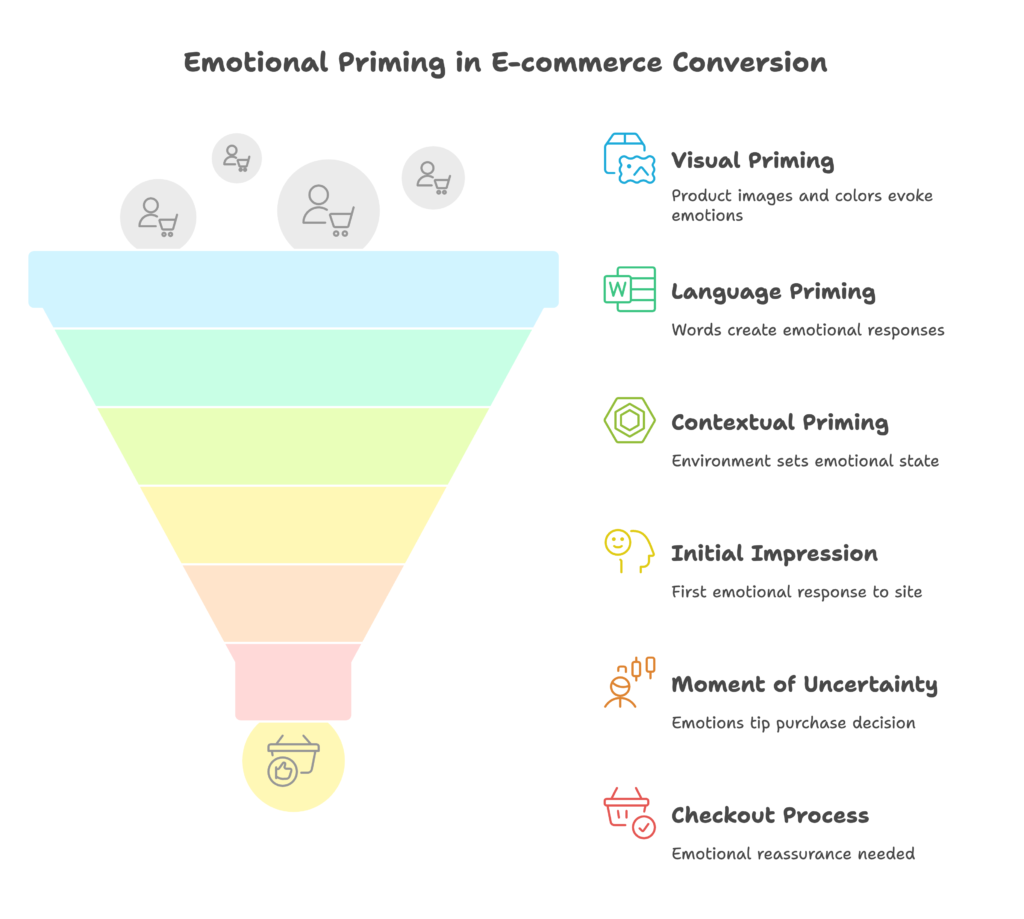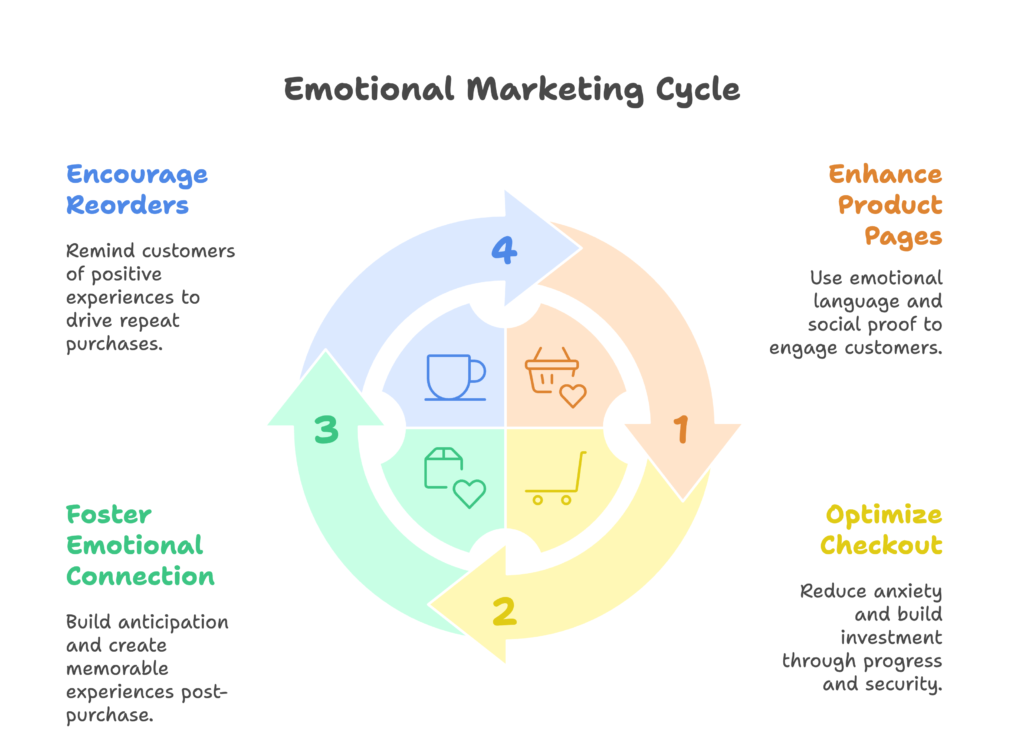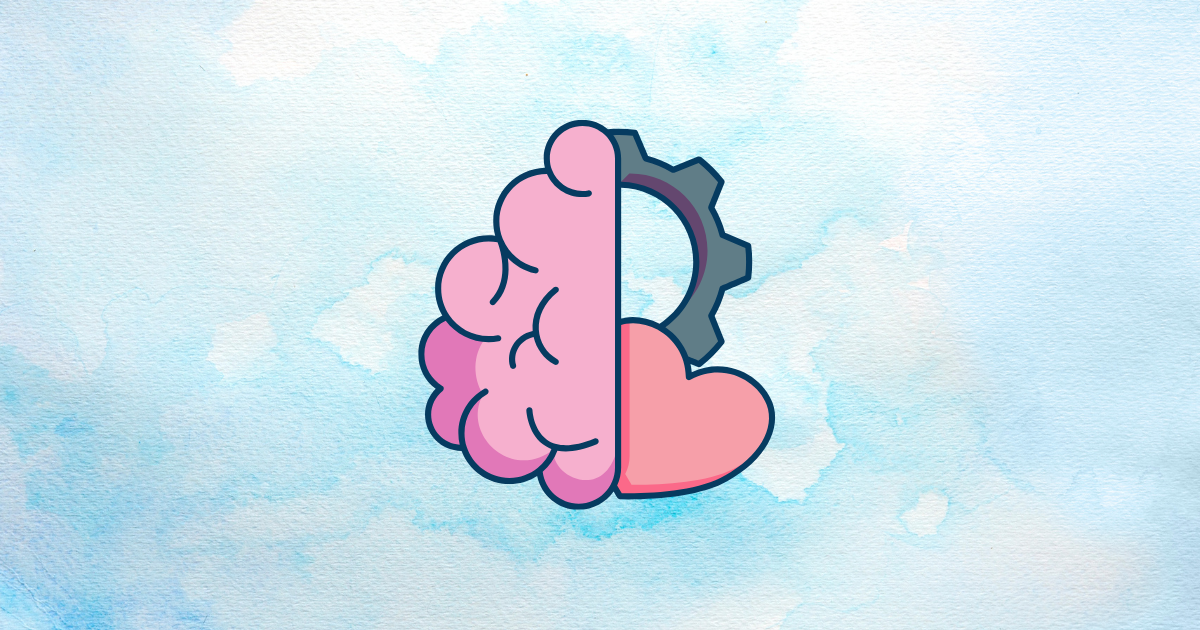Have you ever wondered why you suddenly feel compelled to buy something online? Or why certain websites make you click “Add to Cart” almost without thinking? The secret might be emotional priming – a powerful technique that influences your decisions before you even realize it’s happening.
Every day, successful online stores use psychological triggers to connect with customers on an emotional level. These subtle but effective techniques can be the difference between a visitor who leaves and one who converts. And the best part? You can learn to use these same methods to dramatically increase your own conversion rates.
By reading this article, you’ll discover:
- How your brain processes emotional triggers when shopping online
- Practical techniques to create emotional connections with your customers
- Step-by-step strategies to implement emotional priming on your website
- Real-world examples of brands that have boosted sales using these methods
Ready to unlock the psychology behind higher conversion rates? Let’s dive in!
The Brain Science Behind Emotional Decisions
Before we jump into specific techniques, let’s understand what’s happening in your customers’ brains. This foundation will help you implement emotional priming techniques more effectively and with greater impact.
When a customer visits your online store, their brain is already working in fascinating ways. The amygdala—the brain’s emotional center—processes emotional stimuli faster than the rational parts of the brain can analyze them. This means people often feel before they think.
How Our Brains Process Emotional Shopping Triggers
Three key brain processes influence buying decisions:
- Amygdala activation – This almond-shaped structure processes emotional reactions, especially those related to fear, excitement, and reward. When your website triggers positive emotions, the amygdala creates favorable associations with your products.
- Hippocampal memory formation – Emotional experiences are more likely to be remembered. When customers have positive emotional experiences with your brand, the hippocampus helps cement these memories, making them more likely to return.
- Dopamine reward system – Finding a good deal or discovering the perfect product releases dopamine, creating a pleasant sensation that customers want to experience again.
Our brains also have evolved to prioritize emotional information. This made sense for survival—our ancestors needed to quickly identify threats or opportunities. Today, this same system helps shoppers notice products that connect with their emotional needs.
Now that we understand why emotions drive decisions, let’s see how to strategically use them in your e-commerce store. After all, knowing what happens in the brain is just the beginning—applying this knowledge is where the real magic happens!
How Emotional Priming Works in Online Stores
Emotional priming works by subtly exposing customers to stimuli that trigger specific feelings, influencing their later decisions. But how exactly does this play out in the digital shopping world?

The Three Pathways of Emotional Connection
E-commerce stores can create emotional connections through:
- Visual priming – Product images, colors, and design elements that trigger specific emotions. For example, using warm colors like red and orange can create feelings of excitement and urgency.
- Language priming – Words and phrases that evoke emotional responses. “Limited time offer” triggers fear of missing out, while “join thousands of happy customers” creates a sense of belonging.
- Contextual priming – Creating an overall shopping environment that puts customers in a specific emotional state. Seasonal themes, for instance, can trigger nostalgia or anticipation.
When Emotional Priming Makes the Biggest Impact
Emotional priming doesn’t affect all decisions equally. Its influence is strongest during:
- Initial impressions – The first 50 milliseconds of seeing your site creates an emotional response that colors the entire shopping experience.
- Moments of uncertainty – When customers are on the fence about a purchase, emotions often tip the scales.
- Checkout process – As anxiety rises about spending money, emotional reassurance becomes crucial.
Understanding these principles is important, but knowing how to implement them is where you’ll see real results. Let’s explore the practical strategies that turn these psychological insights into higher conversion rates!
Practical Emotional Priming Strategies
Now that we understand the theory, let’s get practical. Here are specific strategies you can implement today to emotionally prime your customers for conversion.
Visual Emotional Triggers That Convert
Your visual elements create immediate emotional responses:
- Strategic color psychology – Blue builds trust (perfect for payment pages), while red creates urgency (ideal for limited-time offers). One study found changing button colors from green to red increased conversions by 21%.
- Human faces and expressions – Photos of happy customers or models looking at your product naturally draw attention and create positive associations. When people see others enjoying a product, mirror neurons activate, helping them imagine themselves having the same experience.
- Motion and animation – Subtle animations can direct attention and create positive emotional responses. A gentle pulse effect on a “Buy Now” button can increase its visual importance without feeling aggressive.
Words That Trigger Buying Emotions
The language you use creates powerful emotional responses:
- Benefit-focused copy – Focus on how products improve customers’ lives rather than just listing features. “Sleep better tonight” is more emotionally compelling than “Memory foam mattress.”
- Sensory language – Words that evoke physical sensations create stronger emotional responses. “Silky-smooth texture” or “refreshingly cool” help customers imagine using your product.
- Story-based descriptions – Weaving products into mini-stories helps customers emotionally connect. “Imagine yourself on a peaceful morning, sipping this rich coffee as the sun rises” creates an emotional experience rather than just describing a product.
Building Emotional Environments
Create an overall shopping experience that evokes the right emotions:
- Seasonal emotional alignment – Tap into existing emotional states during holidays or seasons. Winter holiday shopping comes with pre-existing feelings of generosity and nostalgia you can enhance.
- Social proof placement – Strategically place reviews and testimonials at moments of decision to provide emotional reassurance when customers need it most.
- Consistent emotional branding – Maintain a consistent emotional tone across all touchpoints to build a coherent emotional relationship with customers.
These strategies are powerful on their own, but the real magic happens when you apply them specifically to increase conversions. Let’s look at exactly where and how to implement these techniques in your conversion funnel!
Conversion-Boosting Emotional Triggers
Now let’s focus on the specific places in your customer journey where emotional priming can directly increase conversion rates.

These targeted approaches can turn browsers into buyers at critical decision points.
Product Page Emotion Triggers
Your product pages are where purchase decisions often hinge on emotional factors:
- Benefit-first descriptions – Lead with emotional benefits before technical details. Instead of “500-thread count cotton,” try “Feel like you’re sleeping on a cloud every night.” This triggers the emotional reward system before rational analysis begins.
- Social proof with emotional weight – Don’t just show star ratings; highlight reviews that describe emotional experiences with your product. “This coffee maker has made my mornings something to look forward to again!” carries more emotional impact than “Works well, good product.”
- Scarcity indicators – “Only 3 left” or “95% booked” creates a tension between desire and potential loss that motivates action. This activates the amygdala’s fear response in a mild but effective way.
Emotional Checkout Optimization
The checkout process is where emotional friction can either kill conversions or boost them:
- Progress indicators – Show how far customers have come in the checkout process, creating a sense of investment and accomplishment that motivates completion.
- Security reassurance – Place security badges and guarantees prominently to reduce anxiety at the moment of payment. The amygdala’s threat-detection system needs calming at this critical point.
- Post-purchase excitement – After checkout, immediately trigger positive emotions with confirmation messages like “Your amazing new shoes are on their way!” This creates a positive final impression that encourages future purchases.
Emotional Retention Strategies
Keeping customers coming back requires emotional connection beyond the first purchase:
- Anticipation building – Send engaging shipping updates that build excitement for product arrival. “Your package has shipped! Just 2 days until your new kitchen will be transformed!”
- Unboxing experience design – Create packaging that delivers an emotional moment when opened. Special packaging, personalized notes, or unexpected small gifts trigger dopamine release and create memorable experiences.
- Emotional reorder reminders – Instead of simply notifying customers it’s time to reorder, remind them of the positive emotional experience: “Ready to experience that perfect cup of coffee again?”
These emotional triggers directly influence conversion rates, but how do you know if they’re working? Let’s explore how to measure and optimize your emotional priming efforts for maximum results.
Measuring Emotional Impact on Conversions
Implementing emotional priming strategies is just the beginning. To maximize their effectiveness, you need to measure their impact and continuously refine your approach. Here’s how to turn emotional priming from an art into a science.
Key Metrics That Reveal Emotional Connection
These metrics help you understand if your emotional priming is working:
- Engagement time – Emotionally engaging content keeps visitors on the page longer. Track time spent on pages before and after implementing emotional priming elements.
- Micro-conversion rates – Monitor small actions like email signups, wishlist additions, or “view details” clicks, as these indicate emotional interest before purchase commitment.
- Abandonment patterns – Analyze where customers leave your site to identify points where emotional connection may be breaking down. High cart abandonment might indicate insufficient emotional reassurance during checkout.
Testing Emotional Variants
Use these testing approaches to optimize your emotional priming:
- A/B testing emotional language – Test different emotional appeals against each other. For example, compare fear of missing out (“Limited time offer!”) against desire for belonging (“Join thousands of satisfied customers”).
- Heat map analysis – Use heat mapping tools to see where customers focus their attention. This reveals which emotional elements are capturing interest and which are being ignored.
- Emotional response surveys – Implement short post-purchase surveys asking how customers felt during their shopping experience. Questions like “What made you decide to complete your purchase today?” can reveal emotional triggers.
By measuring and testing, you can refine your emotional priming strategies for even better results. But don’t just take our word for it—let’s look at real-world success stories that prove the power of emotional priming!
Real-World Emotional Priming Success Stories
Theory and strategies are valuable, but seeing real results makes the power of emotional priming concrete. These case studies demonstrate how businesses have successfully implemented emotional priming to boost their conversion rates.
Fashion Retailer’s Color Psychology Win
A women’s clothing retailer made a simple but powerful change to their product pages:
- They adjusted their color scheme to align with their target emotions—confidence and sophistication—by using deeper blues and purples in their website design.
- Product images were updated to show models with expressions matching the desired emotional state of their customers.
- The result: a 41% increase in add-to-cart actions and a 23% decrease in return rates as customers felt more emotionally aligned with their purchases.
Software Company’s Onboarding Transformation
A SaaS company struggling with new user abandonment implemented emotional priming in their onboarding:
- They redesigned their progress bar to show meaningful achievements rather than just completion steps, creating a sense of accomplishment with each action.
- Each completed task triggered positive reinforcement messaging like “Great job! You’re already becoming a power user!”
- Anxiety-reducing prompts were added at points where users typically abandoned the process.
- The result: a 36% reduction in onboarding abandonment and a 27% increase in feature adoption within the first week.
Subscription Box’s Emotional Retention Strategy
A monthly subscription box service transformed their customer retention through emotional priming:
- They created an anticipation-building email sequence that sent intriguing hints about upcoming box contents, triggering curiosity and excitement.
- Their packaging was redesigned to create a memorable “unboxing moment,” including personalized notes and surprise bonus items.
- Renewal reminders were rewritten to evoke the positive emotions customers experienced when receiving previous boxes.
- The result: a 32% improvement in renewal rates and a 64% increase in social media sharing by customers eager to share their emotional experience.
These success stories show that emotional priming isn’t just theory—it delivers real business results. But with great power comes great responsibility. Let’s explore how to implement these techniques ethically.
Ethical Emotional Priming Practices
Emotional priming is powerful, which means it must be used responsibly. Here’s how to ensure your emotional priming strategies create genuine value for customers while driving conversions ethically.
The Line Between Influence and Manipulation
Understanding this distinction is crucial for ethical implementation:
- Positive emotional enhancement – Ethical priming highlights genuine positive emotions associated with your products. If your skincare truly makes customers feel confident, emphasizing that emotion is ethical enhancement.
- False emotional promises – Creating emotional expectations your product can’t fulfill isn’t just unethical—it’s bad business. Disappointed customers won’t return and may leave negative reviews.
- Protection of vulnerable audiences – Some audiences may be more susceptible to emotional appeals. Extra care should be taken with marketing to children, the elderly, or those in emotional distress.
Building Genuine Emotional Connections
Ethical emotional priming creates authentic relationships:
- Transparency in emotional design – Be open about your methods. Customers appreciate knowing you’ve thoughtfully designed their experience to be positive.
- Cultural sensitivity – Emotional responses vary across cultures. What creates positive feelings in one culture may create confusion or even offense in another. Research cultural differences in emotional response when selling globally.
- Long-term emotional relationship building – Focus on creating lasting positive associations rather than manipulating short-term purchase decisions. This builds sustainable business growth through customer loyalty.
By maintaining ethical standards in your emotional priming strategies, you not only do right by your customers but also build a more sustainable business. Now, let’s look toward the future of emotional priming technologies!
The Future of Emotional Priming in E-Commerce
Emotional priming is evolving rapidly as technology advances. Understanding these emerging trends will help you stay ahead of the curve and prepare for the next generation of customer experiences.
Emerging Technologies for Emotional Connection
These innovations are changing how businesses connect emotionally with customers:
- AI-powered emotion recognition – Machine learning algorithms can now analyze customer behavior to detect emotional states and adapt content accordingly. For example, if browsing patterns suggest hesitation, more reassuring content could be displayed.
- Personalized emotional journeys – Advanced data analysis allows for creating individualized emotional experiences based on past behavior and preferences. Different customers may see entirely different emotional appeals for the same product.
- Immersive emotional environments – Virtual reality and augmented reality shopping experiences create more immersive emotional connections. Imagine trying on clothes in a virtual environment designed to make you feel confident and stylish.
Preparing for the Emotional Commerce Future
To stay ahead, focus on these developing areas:
- Voice commerce emotional design – As voice shopping grows, understanding how to create emotional connections through tone, pacing, and language choices will become increasingly important.
- Multi-sensory emotional branding – Beyond visuals, consider how sound, and eventually even scent and touch, can create cohesive emotional experiences across digital and physical touchpoints.
- Emotional data analysis capabilities – Start building the data infrastructure to understand and act on customer emotional patterns, as this will become a key competitive advantage.
The future of emotional priming offers exciting possibilities for creating more meaningful customer connections. By staying informed about these trends, you’ll be well-positioned to adapt as technology evolves.
Ready to increase your Shopify store’s conversion rates through emotional priming? Growth Suite app provides all the tools you need to implement these emotional priming techniques easily. Start boosting your sales today!
References
- PMC. (2015). Emotional arousal enhances word repetition priming. https://www.ncbi.nlm.nih.gov/pmc/articles/PMC4551502/
- Pruthi, R. (2018). Priming as tactic to increase conversion. LinkedIn. https://www.linkedin.com/pulse/priming-tactic-increase-conversion-feature-adoption-rahul-pruthi
- Frictionless Commerce. (2022). Psychology of Priming. https://frictionless-commerce.com/blog/priming-not-used-enough-in-ecommerce/
- SSRN. (2020). Affective Priming in Advertising. https://papers.ssrn.com/sol3/papers.cfm?abstract_id=3712163
- AllDGT. (2021). Priming in Marketing Examples. https://alldgt.com/priming-in-marketing/
- Sage Journals. (1995). Emotion-Specific Priming Effects. https://journals.sagepub.com/doi/abs/10.1177/0146167295216001
- HypeInsight. (2024). Priming in Online Marketing. https://hypeinsight.com/priming-a-powerful-yet-invisible-tool-for-online-marketing/
- Teqnite. (2024). Science of Priming in Marketing. LinkedIn. https://www.linkedin.com/pulse/subtle-science-priming-marketing-teqnite-n3wqf




